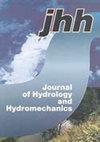Comparative analysis of numerical solutions of 2D unsteady dambreak waves using FVM and SPH method
IF 2.4
4区 环境科学与生态学
Q3 WATER RESOURCES
引用次数: 0
Abstract
Abstract This work presents a comparison of two-dimensional numerical solutions of unsteady free surface flow. This is a simulation of the dam-break wave with different configurations using based-mesh finite volume method and meshless smoothed particle hydrodynamics (SPH). Two well-known approaches, widely used in the computational fluid dynamics (CFD). These techniques have proven their robustness in the numerical treatment of such conservation laws. The main goal is to check the ability of the SPH method and the first order finite volume HLLC solver to reproduce the numerical solutions of the 2D shallow water equations. Based on many benchmark tests, one investigates the effect of the topographic variation along the x and y directions on behavior of the numerical solutions namely at the wet-dry front. The comparison between the simulated results, the analytical solutions and the experimental measurements shows a good correlation, although the finite volume approach remains more advantageous in terms of accuracy and the CPU time.二维非定常溃坝波FVM和SPH数值解的对比分析
本文对非定常自由表面流的二维数值解进行了比较。这是使用基于网格有限体积法和无网格光滑粒子流体动力学(SPH)对不同配置的溃坝波进行模拟。两种众所周知的方法,广泛用于计算流体动力学(CFD)。这些技术已经在对这些守恒定律的数值处理中证明了它们的稳健性。主要目标是检查SPH方法和一阶有限体积HLLC求解器再现二维浅水方程数值解的能力。基于许多基准测试,研究了沿x和y方向的地形变化对数值解行为的影响,即在干湿锋处。模拟结果、解析解和实验测量之间的比较显示出良好的相关性,尽管有限体积方法在精度和CPU时间方面仍然更有利。
本文章由计算机程序翻译,如有差异,请以英文原文为准。
求助全文
约1分钟内获得全文
求助全文
来源期刊
CiteScore
4.20
自引率
5.30%
发文量
30
审稿时长
>12 weeks
期刊介绍:
JOURNAL OF HYDROLOGY AND HYDROMECHANICS is an international open access journal for the basic disciplines of water sciences. The scope of hydrology is limited to biohydrology, catchment hydrology and vadose zone hydrology, primarily of temperate zone. The hydromechanics covers theoretical, experimental and computational hydraulics and fluid mechanics in various fields, two- and multiphase flows, including non-Newtonian flow, and new frontiers in hydraulics. The journal is published quarterly in English. The types of contribution include: research and review articles, short communications and technical notes. The articles have been thoroughly peer reviewed by international specialists and promoted to researchers working in the same field.

 求助内容:
求助内容: 应助结果提醒方式:
应助结果提醒方式:


